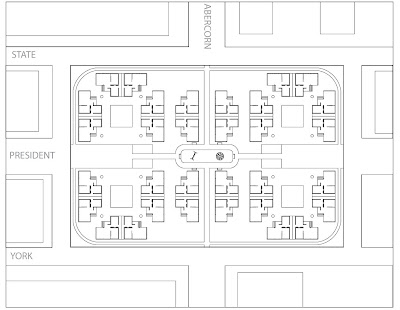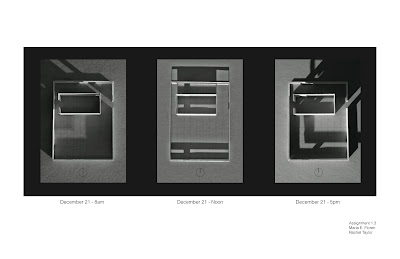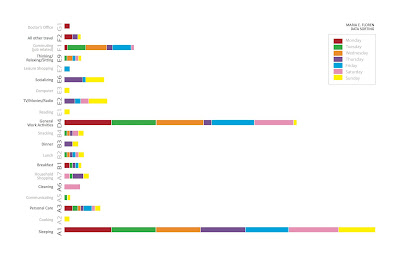







We then built basswood models of the four types and did light studies of them using the heliodon in the Lighting Lab, photographing them at different times of the day and different days of the year.

From those models we went back to doing individual work and each chose one of the typologies from the models we did and built a larger scale foam core model. I chose to continue with the divided typology. The plan illustrates division of the space in quadrants, and the apertures and thresholds help strengthen the typology.
We also did orthographic drawings of this final space.
With the larger scale model we built, we did another light study in the Lighting Lab, this time using the artificial sky and the online WEBHDR software.



So! With the idea of division, the apertures and thresholds really signify the different spaces created within the quadrants, which is what led me to do this collage. It basically tells a story of a person who wants to explore and this room could sort of be a capsule which enables them to do that. From one extreme of exploration to another, as far as outer space and as deep as the ocean. Below is our final presentation!
During the previous assignment we took a break mid way and had an assignment of graphically representing data. This data was collected prior to class starting earlier in the summer and we had to account for every 30 minutes from Monday-Sunday. Each person used a different persons data to represent.


Allllllllllll that within the first 3 weeks of the class!
Our final project was based around our five-day class trip to Charleston, South Carolina and Savannah, Georgia. In Charleston we stayed at the Inn at Middleton Place, a contemporary inn on the grounds of Middleton Place, which has a historical landmarks and gardens. We also stopped in-between the two cities in South Carolina to do some charcoal drawings of the Sheldon Church Ruins, which was an old church from the mid 1700s. Below are some photographs taken on the trip, I apologize for the layout of the photos below...I couldn't organize it nicely!
Our final project was to design an emergency shelter.
We had two sites to chose from to do our project. One was a waterfront park in Charleston and the other was one of the squares in downtown Savannah. Below are the photo analyses I did for both of the sites.
Study of light & shadow, Charleston site

Surrounding city "thresholds", Charleston
So, for my project I chose to do the Savannah site, Oglethorpe Square. Savannah's riverfront downtown is made up of park like squares about every other block. Below are the photo analyses & diagrams of the site I've created.
 Elevation Diagrams, Savannah, GA
Elevation Diagrams, Savannah, GASavannah diagram analysis, Oglethorpe Square & other surrounding squares
My next post will show my process & final images for the MUDD 5050 project, and that'll conclude the summer semester assignments. After that I'll be blogging about the projects, assignments, & thoughts as a graduate student in the Master of Urban Design program, so keep following! :)